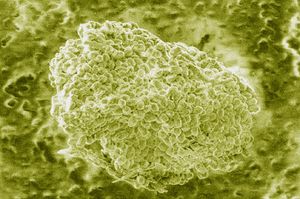Anthracimycin
Introduction
Anthracimycin is an antibiotic discovered in 2012 that is able to kill gram-positive bacteria, namely anthrax (Bacillus Anthracis). It also may be able to kill methicillin-resistant staphylococcus aureus (MRSA), and therefore is an extremely relevant research topic. MRSA is a growing problem in the modern world because of its astonishing capacity to develop drug resistance, so a new antibiotic that defends again MRSA would be a revolutionary discovery. It was found in an ocean microbe called Streptomyces sp. off the shores of Santa Barbara, California. Professor Wiliam Fenical, along with his team of researchers, discovered the compound.

Chemical Structure of Anthracimycin

Anthracimycin, according to Professor Fenical, has a "new and unique chemical structure" (Aguilera). New antibiotics do not often have completely unique structures, which is what makes the discovery of anthracimycin particularly important. The chemical formula of anthracimycin is C25H32O4. It is composed of three rings: one has fourteen carbon atoms, and two have six carbon atoms each. These rings are of a polyketide origin, which simply means that the rings have two or more carbonyl groups connected by a single carbon atom (Jang et. al).
The most closely related compound to anthracimycin is chlorotonil. Chlorotonil differs from anthracimycin in that it contains two chlorine atoms and it has a slightly different carbon skeleton (Jang et. al).
The technique used to determine the chemical structure of anthracimycin is called spectroscopy. Spectroscopy is a process often used to study the structure of molecules. It involves determining the wavelength of different elements of a molecule, and using that information to determine its chemical structure.
Method of Action and Potential Uses
The method of action of anthracimycin is not yet determined. Scientists initially hypothesized that it inhibited DNA/RNA synthesis, but follow-up studies (Jang et. al) rejected this hypothesis. Anthracimycin has been shown to effectively kill gram positive bacteria. It has been proven effective against the spore-forming bacterium Bacillus anthracis, which causes an infectious disease called anthrax. This bacterium has been used most notably as a bioterrorism weapon. Anthrax is potentially lethal, and can require months of treatment with multiple antibiotics ("Anthrax Killer from the Sea"). Therefore, discoveries of new antibiotics to treat anthrax are medically significant. Anthracimycin also showed antimicrobial activity against staphylococci, enterococci, and streptococci. Based on this action, scientists predict that it may be able to kill MRSA, another gram-positive bacterium.
In the Jang, et. al. study, two chlorine atoms were added to anthracimycin to determine whether the addition of chlorine changes the antibiotic's effectiveness. The addition of chlorine atoms reduced anthracimycin's effect on Bacillus anthracis by about half. However, adding chlorine atoms increased its activity against certain gram-negative bacteria. These bacteria, such as E. coli and H. influenzae, often develop drug resistance. Therefore, this derivative of anthracimycin may also prove to be medically useful.
Conclusion
Research on anthracimycin is still in the early stages. The antibiotic shows promising potential against gram-positive bacteria, and possibly gram-negative bacteria as well. The discovery of new antibiotics is key to staying ahead of bacterial evolution so that treatments against infections are always effective.
References
Aguilera, Mario. "Compound Discovered at Sea Shows Potency against Anthrax." Scripps Institution of Oceanography. 17 July 2013. Web. 05 Nov. 2013.
"Anthracimycin: New Antibiotic Kills Anthrax, MRSA." Scinews.com. 19 July 2013. Web. 05 Nov. 2013.
"Anthrax Killer from the Sea." Chemistry Views. 01 July 2013. Web. 7 Nov. 2013.
Chu, Steven, et. al. "Spectroscopy." Encyclopedia Britannica Online. Encyclopedia Brittannica Inc. Web. 1 Dec. 2013.
Jang, Kyoung H, et. al. "Anthracimycin, a Potential Anthrax Antibiotic from a Marine-Derived Actinomycete." Angewandte Chemie International Edition 52.30 (2013): 7822-824. Wiley Online Library. Web. 7 Nov. 2013.
"Polyketide." Merriam-Webster. Web. 7 Nov. 2013.
Edited by [Emily Vachon], student of Joan Slonczewski for BIOL 116 Information in Living Systems, 2013, Kenyon College.
